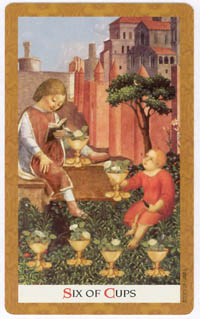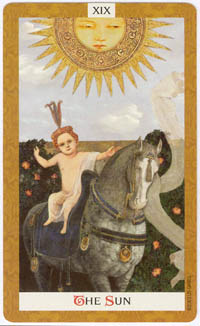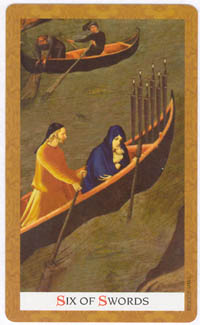|
 From US Games Systems Inc. comes a tarot deck, which in more than one way deviates from this
publisher's usual tarot program. It is not even necessary to look at the deck itself to realize
that this is different; alone the two-part top-lidded, very heavy box it comes in, probably
handmade (I can't imagine a box like this could be made on a machine), makes it look like a very
prestigious and costly product (when do we, btw, get a standard nomenclature for describing
different types of boxes?) The deck's name is "Golden Tarot" and the artist is Kat Black, who
is an Australian. Besides the 78 + 2 card deck, the box holds a 199 page illustrated book in
the same size as the cards. When I first heard the deck's name, my immediate thought was that
US Games had incorporated gold foils in the images, as Lo Scarabeo has done it for some years,
but that is not the case. The gold in the Golden Tarot is limited to the edges and that is
elaborate enough.
From US Games Systems Inc. comes a tarot deck, which in more than one way deviates from this
publisher's usual tarot program. It is not even necessary to look at the deck itself to realize
that this is different; alone the two-part top-lidded, very heavy box it comes in, probably
handmade (I can't imagine a box like this could be made on a machine), makes it look like a very
prestigious and costly product (when do we, btw, get a standard nomenclature for describing
different types of boxes?) The deck's name is "Golden Tarot" and the artist is Kat Black, who
is an Australian. Besides the 78 + 2 card deck, the box holds a 199 page illustrated book in
the same size as the cards. When I first heard the deck's name, my immediate thought was that
US Games had incorporated gold foils in the images, as Lo Scarabeo has done it for some years,
but that is not the case. The gold in the Golden Tarot is limited to the edges and that is
elaborate enough.
The second way the deck deviates from most, if not all, US Games' decks is, that it is a collage
deck. At least I can't recall any other collage decks in their program. That it is created entirely
on a computer is no longer unusual, many commercial tarot decks are nowadays.

What is the deck like? Well, it is sort of a topsy-turvy treatment of - guess what? - the good old
1909 Waite-Smith Tarot. Normally, when tarot deck creators or illustrators (I won't call them
"artists"), produce their variations of this deck, they bring their efforts forward in time from
the beginning of the 20th century, when Pamela Colman Smith created her images. Kat Black has done
the opposite by recreating Pamela Colman Smith's characters and situations by cutting bits and
pieces out of old paintings to place them in Late Middle-Age or Renaissance environments;
actually the environment in which the very first tarot decks ever were created. The Golden Tarot
is very well done, it takes a great deal of computer experience and training to manipulate with
as many as 20 layers in an image, which Ms. Black states there are.
When I mentioned the deck to an American tarot friend of mine, she asked "What do you think of the
deck? It looks very impressive. Is it useful though? Many decks are very pretty but have no depth".
Later she expanded the question: I realize now the question about `useful' was vague. I meant to
ask if it had a coherent system in of itself and was not just a copy of RWS or Marseille dressed
up in different clothes - so many decks change the trappings on the cards and completely lose
meaning - pretty pictures of Chinese people on a RWS-style deck don't make sense!"
She is definitely right. Golden Tarot is just another Waite-Smith Tarot deck dressed up in
different clothes, this time in Renaissance clothes. There is no real use for it. There is nothing
added to the concept of tarot. It is not an improvement of the genuine Waite-Smith Tarot which it
takes its basis from. It is not a new and original artistic interpretation; it is just an exercise
in computer artistry. It doesn't make sense. It is not "useful".

The accompanying book of 199 pages doesn't make much sense either. We get a lot of American style
acknowledgments, a nine page introduction, ten pages of card spreads, about ninety pages of
card descriptions (which we can see with our own eyes) and some standard interpretations. The
remaining eighty pages are a list of the sources the illustrations are lifted from.
All this doesn't mean that the Golden Tarot will not be successful. It undoubtedly will. The artist
has prepared the ground by presenting the images on the Internet, promoting the publication, telling
in detail the story about its coming into physical being including attempts of early pirated editions
and, in the last stages, the delays that occurred in transit from the printers. After its
publication, she additionally offered signed single cards for sale on Ebay, supposed to be added to
the deck bought from US Games to make it into an "artist signed deck", a quality which seems to be
en vogue. What an enterprise! The deck will undoubtedly be a success and thus earn its major
purpose: to add to the bank accounts of the artist and producer.
One could expect that this elaborate product (it is elaborate: well printed, gilt edged, beautiful
sturdy box, an illustrated 199 pages book) would cost a lot. It does not. It is just
the standard US $25.- not more than most mass market tarot decks cost.

It shall be no secret, that I would have preferred that all the work, effort and cost put into this
production instead had been used to produce the true facsimile of the very first Waite-Smith Tarot
deck, which US Games Systems owe us as proper recognition of the original creators of the
Waite-Smith Tarot. A facsimile in the true sense of the word, "an exact copy" of the first
Waite-Smith deck, with the original print screen preserved and, of course, including an exact copy
of the box and of Waite's "Key". That exact copies can be made, we have recently seen an example
of it in the reprint of Dondorf's Java pack, where there is no discernible difference between
the original and facsimile.
Back to the "Golden Tarot", which this should be all about. What's the reason for it's very
reasonable price? Twice as much would still be reasonable. Can we expect future products from
US Games Systems Inc. to be cheaper? Have the artist and publisher voluntarily minimized their
profit for a good course? Sorry, but I can not help thinking of all the tiny Chinese fingers gluing
all those lovely boxes as "...a big job for a very low payment......"
|